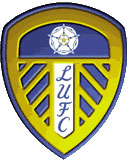 |
 |
 |
History
of the Club - Origins of Football
How
the game began and reached Britain
Football, like the poor and taxation, has been around
for centuries, although many of its Geoffrey Green: 'What has been revealed, though,
by the researches of a certain Professor at Cambridge University, H A
Giles, is that there was some form of football in China long before the
Romans of Julius Caesar brought their game of harpastum to Britain. 'The Chinese, indeed, point to one of the earliest
known references to football in the period belonging to the mythical Yellow
Emperor of the third Millennium BC. If there is no hard proof to support
that, at least there is evidence about the game being in existence in
the Third and Fourth Centuries BC. At that point it was part of the military
training of the period, and the evidence of it can be seen in a military
textbook of twenty-five chapters dating some 2,000 years ago from the
Han dynasty. The History of the Han Dynasty spans the period 206 BC to
AD 25, and it is there that there is discovered a true reference to some
early stirring, by the use of the words tsu chu. Tsu meant
"to kick with the foot"; chu was "the ball made
of leather and stuffed". 'Japan, too, can point to a game called kemari
which has been played there for some fourteen centuries. The ground was
roughly 14 square metres in size. In the North West corner there stood
a pine tree, a willow to the South East, a cherry tree to the North East
and a maple to the South West. Eight players made up the game, which consisted
of kicking a ball from one to another. The suggestion is that some religious
ceremony was attached to this.' There are stories of variations being played all
over Europe in medieval times - in Italy in 1555 a form of street football
was being played in Venice and from 1595, also in Florence, where it was
known as calcio. In France, Germany, Holland and Russia there are
references to football from around the same time. The British version of the game is thought to have
been inspired by the Romans, when they imported harpastum (a Roman word
for 'handball'). It was an individual ball game with physical contact
a significant feature, and was developed from the rather more genteel
episkyros of the Ancient Greeks. The Roman legions may well have
played the game as they awaited their return to sunnier climes. Back in
Italy, the game had developed into calcio by the Sixteenth Century. Harpastum was a game something akin to Rugby
and was used as a form of military training to improve the physical fitness
of Roman legionnaires. It was known as the Small Ball Game to distinguish
it from other games involving much larger balls. The Harpastum ball was
made from a stitched leather skin, stuffed with chopped sponges or animal
fur, and was around 8 inches in diameter. It involved two sides of approximately
the same strength competing in a restricted space, striving to take a
hollow ball beyond a certain mark at either end of the field of battle.
The methods they employed in doing so were no holds barred and included
wrestling. Footballnetwork.org: 'The game of football generally
flourished in England from around the 8th Century onwards. The game was
incredibly popular with the working classes and there were considerable
regional variations of the game throughout the country. 'The level of violence within the game was astonishing.
Players were kicked and punched regularly by opponents. In addition to
any personal injury that occurred, countless property items were destroyed
in the course of a match. Fields were often ruined, as were fences and
hedges. Damage also occurred to people's houses and businesses within
the main streets of the village (or wherever the game travelled in its
course). 'For people living within the cities, football was
still an alien concept and considered to be a "rural custom".
However, in the second half of the 12th Century football had established
itself in London. By 1175 an annual competition had been established in
the capital and every Shrove Tuesday the game created huge interest and
gained further popularity. 'The future development of the urban game is not
well known but some early records do mention the violent nature of the
game within cities - there is even a mention of a player being stabbed
to death by an opponent! Records also point to women being involved in
the game during the 12th Century.' The first description of a football match in England
was written by William FitzStephen in about 1170. He records that while
visiting London he noticed that 'after dinner all the youths of the city
goes out into the fields for the very popular game of ball.' He points
out that every trade had their own football team. 'The elders, the fathers,
and the men of wealth come on horseback to view the contests of their
juniors, and in their fashion sport with the young men; and there seems
to be aroused in these elders a stirring of natural heat by viewing so
much activity and by participation in the joys of unrestrained youth.' A few centuries later another monk wrote that football
was a game 'in which young men ... propel a huge ball not by throwing
it into the air, but by striking and rolling it along the ground, and
that not with their hands but with their feet.' The writer strongly condemned
the game claiming it was 'undignified and worthless' and that it often
resulted in 'some loss, accident or disadvantage to the players themselves.' One manor record, dated 1280, states: 'Henry, son
of William de Ellington, while playing at ball at Ulkham on Trinity Sunday
with David le Ken and many others, ran against David and received an accidental
wound from David's knife of which he died on the following Friday.' In
1321, William de Spalding was involved in a similar incident: 'During
the game at ball as he kicked the ball, a lay friend of his, also called
William, ran against him and wounded himself on a sheath knife carried
by the canon, so severely that he died within six days.' There are a number
of other recorded cases during this period of footballers dying after
falling on their daggers. Geoffrey Green: 'At that period youths of the city
of London chased footballs in Smithfield; later football players made
their mark at Covent Garden, Cheapside and the Strand, Fleet Street, Moorfields
and Lincoln's Inn Fields in London. Prints still survive as proof of this. 'In other parts of the country, Derby, Nottingham,
Dorking and Kingston-on-Thames arose as points in the spread of the game.
'At Derby, Ashburton and elsewhere there grew up
the fierce Shrove Tuesday games. They were scarcely games, of course.
They resembled a free for all battle more than anything else, but they
represented a traditional beginning. Here was all in wrestling combined
with unarmed combat as sections of the community chased the ball through
the streets. Thus there arose the name 'mob football', out of which finally
developed the game we now know. 'The Shrove Tuesday match at Derby, in fact, survives
to this day. It is traditional. It began there when the young men of the
parish of All Saints challenged those of the parish of St Peter. Since
all men over the age of eighteen took part, trying to force the ball from
one parish into the other - each parish representing the goal - the teams,
as it were, often numbered over 500 apiece. Two marks were made, one at
Nun's Mill, the other at Gallows Balk on the Ormaston Road, and the object
was to force the ball to one or other of these.' The Shrove Tuesday contest is one of the earliest
recorded indigenous football games, being first reported in AD 217. Even then, the game had spread far and wide: Dorset's
Corfe Castle and Scone in Scotland were among other venues where an annual
Shrove Tuesday fixture took place. At Chester, a leather ball was introduced,
the City Hall and the hall at Rodehoe being the goals for the game. Few,
however, played on pitches such as the one recorded in Cornwall in 1602,
whose goals were three to four miles apart and the teams were each comprised
of the menfolk of two or three neighbouring parishes. London was at the
forefront of these mob football games. One really curious thing about the game in England
is the way that it has survived and even thrived in spite of fierce and
formal opposition from the powers that be. By the reign of Edward II, football had become so
popular, with so many people joining in with games in the streets that
the merchants of London protested to the King that it was an obstacle
to their trade and should be banned. On April 13 1314, Edward II issued
a decree forbidding the game: 'For as much as there is great noise in
the city caused by hustling over large balls ... from which many evils
might arise, which God forbid: we command and forbid on behalf of the
King, on pain of imprisonment, such game to be used in the city in future.' The edict had an initial impact, but football soon
re-emerged as a popular pastime. Indeed, it was so popular that it was
feared that the royal subjects were spending too much time honing their
ball skills at the expense of their dexterity with the longbow. In 1349,
Edward III issued another banning order, reasoning that 'the skill at
shooting with arrows was almost totally laid aside for the purpose of
various useless and unlawful games'. The pattern continued. Forty years later, Richard
II passed a similar statute forbidding 'all playing at tennise, football
and other games called corts, dice, casting of the stones, kailes and
other such importune games'. Henry IV had to reissue the same commandment
in 1401. In 1457 James III of Scotland decreed that 'football
and golfe be utterly cryed down and not to be used', while in 1491 his
successor commanded that 'in no place of this realme ther be used futeball,
golfe or other sik unprofitable sportes'. Henry VIII also banned the game
and even rendered it a penal offence by statute for anyone to keep a house
or ground devoted to such things as cards, dice and football. Elizabeth I decreed that 'no foteballe play to be
used or suffered within the City of London'. During her reign, the grand
jury of Middlesex County found 'that on the said day at Ruyslippe, County
of Middlesex, Arthur Reynolds, husbandman (with five others, all of Ruyslippe),
Thomas Darcye, of Woxbridge, yeoman (with seven others), with unknown
malefactors to the number of one hundred, assembled themselves unlawfully
and played a certain unlawful game called foote-ball, by means of which
unlawful game there was amongst them a great affray likely to result in
homicides and serious accidents ...' Wilfried Gierhardt: 'The passion for football was
particularly exuberant in Elizabethan times. An influence that most likely
played a part in intensifying the native popularity for the game came
from Renaissance Italy, particularly from Florence, but also from Venice
and other cities that had produced their own brand of football known as
calcio. lt was certainly more organised than the English equivalent and
was played by teams dressed in coloured livery at the important gala events
held on certain holidays in Florence. It was a truly splendid spectacle.
In England the game was still as rough and ungracious and lacking in refinement
as ever, but it did at this time find a prominent supporter who commended
it for other Much of the reason for the sustained official opposition
was the general opinion that football was 'a very vulgar and unfashionable
pastime', enjoyed mainly by commoners. For centuries, any such game that
was 'not connected in any way with knightly skill was considered unfit
for a gentleman of equestrian rank'. In 1608 the Manchester Lete Roll of October 12 contained
a resolution: 'That whereas there has been heretofore great disorder
in our towne of Manchester, and the inhabitants thereof greatly wronged
and charged with makinge and amendinge of their glasse windows broken
yearelye and spoyled by a companye of lewd and disordered psons using
that unlawfull exercise of playinge with the ffote-ball in ye streets
of ye sd towne breakinge many men's windowes and glasse at their plesures
and other great enormyties. Therefore we of this jurye doe order that
no manner of psons hereafter shall play or use the footeball in any street
within the said towne of Manchester, subpoend to evyeone that shall so
use the same for evye time.' Unsurprisingly the Puritans were equally concerned,
regarding football as a form of unseemly revelry. In 1683, the author
Stubbes wrote thus: 'Lord remove these exercises from the Sabbath. Any
exercise which withdraweth from godliness, either upon the Sabbath or
any other day, is wicked and to be forbidden. Now who is so grossly blind
that seeth not that these aforesaid exercises not only withdraw us from
godliness and virtue, but also hail and allure us to wickedness and sin?
For as concerning football playing I protest unto you that it may rather
be called a friendly kind of fight than a play or recreation - a bloody
and murdering practice than a fellow sport or pastime. For doth not everyone
lye in wait for his adversary, seeking to overthrow him and punch him
on his nose, though it may be on hard stones, on ditch or dale, on valley
or hill, or whatever place so ever it be he care not, so he have him down;
and that he can serve the most of this fashion he is counted the only
fellow, and who but he? So that by this means sometimes their necks are
broken, sometimes their backs, sometimes their legs, sometimes their arms,
sometimes their noses gush out with blood, sometimes their eyes start
out, and sometimes hurt in one place, sometimes in another ... Football
encourages envy and hatred ... sometimes fighting, murder and a great
loss of blood.' A writer called Moor at the end of the Eighteenth
Century described the way the game was played at that time: 'Each party has two goals, ten or fifteen yards
apart. The parties, ten or fifteen on a side, stand in line facing each
other at about ten yards distance midway between their goals and that
of their adversaries. An indifferent spectator throws up a ball the size
of a cricket ball midway between the confronted players and makes his
escape. The rush is to catch the falling ball. He who first can catch
or seize it speeds home, making his way through his opponents and aided
by his own sidemen, If caught and held, or rather in danger of being held,
for if caught with the ball in possession he loses a snotch, he throws
the ball (he must in no case give it) to some less beleaguered friend
more free and more in breath than himself, who, if it be not arrested
in its course or be jostled away by the eager and watchful adversaries,
catches it. Then he in like manner hastens homeward, in like manner pursued,
annoyed and aided, winning the notch or snotch if he contrive to carry
or throw it within the goals. At a loss or gain of a snotch a recommencement
takes place. When the game is decided by snotches seven or nine are the
game, and these if the parties are well matched take two or three hours
to win. Sometimes a large football was used; the game was then called
"kicking camp"; and if played with shoes on, "savage camp".' Geoffrey Green: 'There is no doubt that Puritanism
put a damper on football 'Up to the age of the Puritans, football certainly
was a national sport. But from the Restoration onwards, for something
like two hundred years, there was a steady decline in its popularity until
an athletic revival in the early Nineteenth Century; though for the latter
part of this period, football became a school sport. However, from the
declining references made to the game by the Eighteenth Century writers,
it seems that football at that point had lost much of its national popularity. 'In the reign of Charles II, however, it appears
that football still held sway in London, understandably enough, because
Charles himself was a great patron of most athletic sports. In 1691, indeed,
Charles II attended a match played between his own servants and the Duke
of Albemarle's - the first recorded instance of royal patronage of football.' About this time, there was something of a change
in the nature of the English game. J R Witty: 'During Cromwell's supremacy,
many Royalists left England, and in their enforced absence overseas some
of the Cavaliers saw at Florence and Sienna in Italy a game called calcio.
This was a football match between two teams, limited in number and played
in a restricted space, with the players clothed in distinctively coloured
uniforms. Play was governed by recognised rules, with prescribed forms
of etiquette and exchange of courtesies between the contesting teams.
It had some slight resemblance to the kind of game played by Roman soldiers
centuries before. 'The game itself was both a spectacle and an entertainment
at which ladies could be present. They wore or displayed coloured favours
as team supporters, and the houses round the field were gaily decorated
with similar colours, which added to the gaiety of the scene. It was not
unlikely that these Cavaliers with their sense of colour were impressed,
and that they brought back to this country from their exile a liking for
this more spectacular and more disciplined form of the game. 'Certainly, when a match was staged in 1681 between
the servants of the King and those of the Duke of Albemarle, the whole
lay out was not of the mob game type. A painting on wood is extant, which
I have seen; and my opinion is that it pictures a match of the more modern
type. Teams of equal numbers dressed in highly coloured distinctive clothing
oppose one another on a field more oval than rectangular in shape. At
either end is a wooden fort with an open doorway guarded by a custodian;
near each is a uniformed drummer and another man carrying something like
an axe, evidently to notch or score any wins. The ball is being kicked
about in attempts to drive it through one of the doorways. Around the
ground, the mock battlefield, are the spectators, some obviously of the
lower classes, others in more splendid clothing, whilst in a decorated
pavilion at one side are some evidently quite distinguished people. 'One thing is outstanding: this game was in quite
a different category from the old undisciplined kind.' At the beginning of the 1800s, however, football
was in decline as a direct result of the earlier Puritan oppression. Joseph
Strutt, a great historian of English sports, writing in 1801, said of
football: 'The game was formerly much in vogue among the common people,
though of late years it seems to have fallen into disrepute and is but
little practised.' He continued, 'When a match at football is made,
two parties, each containing an equal number of competitors, take the
field, and stand between two goals, placed at the distance of eighty or
an hundred yards the one from the other. The goal is usually made with
two sticks driven into the ground, about two or three feet apart. The
ball, which is commonly made of a blown bladder, and cased with leather,
is delivered in the midst of the ground, and the object of each party
is to drive it through the goal of their antagonists, which being achieved
the game is won. The abilities of the performers are best displayed in
attacking and defending the goals; and hence the pastime was more frequently
called a goal at football than a game at football. When the exercise becomes
exceeding violent, the players kick each other's shins without the least
ceremony, and some of them are overthrown at the hazard of their limbs.' In 1815 Hone provided this description in his Everyday
Book of Football Day at Kingston-on-Thames, when travellers to Hampton
Court could see upon entering Teddington 'all the inhabitants securing
the glass of their front windows from the ground to the roof, some by
placing hurdles before them, and some by nailing laths across the frames.
At Twickenham, Bushy and Hampton Wick they were all engaged in the same
way. 'At about 12 o'clock the ball is turned loose to
those who can kick it. There were several balls in the town of Kingston
and of course several parties. I observed some persons of respectability
following the ball; the game lasts about four hours, when the parties
retire to the public houses.' Geoffrey Green: 'This, at least, shows that though
football may have declined it was not extinguished. It When Cambridge University introduced football into
their curriculum at the turn of the Seventeenth Century, even its detractors
had to reconsider. But with a welter of different rules proliferating,
these games were strictly intramural affairs. With the advent of the Industrial
Revolution, few of the downtrodden working classes had the time or energy
to pursue such a physically demanding sport - and football passed into
the hands of the leisured upper classes. Each public school, it seemed, had its own special
set of rules, often influenced by the physical characteristics of the
location in which the game was played. At Charterhouse, where the stony
cloisters provided the pitch for 20 players a side, the ball was played
by feet alone; at Rugby, handling (but not running in possession) was
positively encouraged. Harrow played a recognisable form of today's game
on grass, 11 players making up a team, while Winchester's goals extended
the entire length of the goal line, rather like Rugby's try line today. Thomas Arnold was appointed headmaster of Rugby
in 1828. He had a profound and lasting effect on the development of public
school education in England. Arnold introduced mathematics, modern history
and modern languages and introduced the prefect system to keep discipline.
He modernised the teaching of Classics by directing attention to literary,
moral or historical questions. Although Arnold held strong views, he made
it clear to his students they were not expected to accept those views,
but to examine the evidence and to think for themselves. Arnold also had a good method for 'encouraging senior
boys to exercise responsible authority on behalf of the staff'. He argued
that games like football provided a 'formidable vehicle for character
building'. Each school had its own set of rules and style of
game. In some schools the ball could be caught, if kicked below the hand
or knee. If the ball was caught near the opposing goal, the catcher had
the opportunity of scoring, by carrying it through the goal in three standing
jumps. Rugby, Marlborough and Cheltenham developed games
that used both hands and feet. The football played at Shrewsbury and Winchester
placed an emphasis on kicking and running with the ball (dribbling). School
facilities also influenced the rules of these games. Students at Charterhouse
played football within the cloisters of the old Carthusian monastery.
As space was limited the players depended on dribbling skills. Whereas
schools like Eton and Harrow had such large playing fields available that
they developed a game that involved kicking the ball long distances. According to one student at Westminster, the football
played at his school was very rough and involved a great deal of physical
violence: 'When running ... the enemy tripped, shinned, charged with the
shoulder, got down and sat upon you... in fact did anything short of murder
to get the ball from you.' Football games often led to social disorder. As
Dave Russell pointed out in Football and the English (1997), football's
'habit of bringing the younger element of the lower orders into public
spaces in large numbers (was) increasingly seen as inappropriate and,
indeed, positively dangerous in an age of mass political radicalism and
subsequent fear for public order.' Action was taken to stop men playing football in
the street. The 1835 Highways Act provided for a fine of 40s for playing
'football or any other game on any part of the said highways, to the annoyance
of any passenger.' In 1840 soldiers had to be used to stop men playing
football in Richmond. Six years later the Riot Act had to be read in Derby
and a troop of cavalry was used to disperse the players. There were also
serious football disturbances in East Molesey, Hampton and Kingston-upon-Thames. Although the government disapproved of the working
classes playing football, it continued to be a popular sport in public
schools. In 1848 a meeting took place at Cambridge University to lay down
the rules of football. As Philip Gibbons points out in Association
Football in Victorian England (2001), 'The varying rules of the game
meant that the public schools were unable
to compete against each other.' Teachers representing Shrewsbury, Eton,
Harrow, Rugby, Marlborough and Westminster, produced what became known
as the Cambridge Rules. One participant explained what happened: 'I cleared
the tables and provided pens and paper ... Every man brought a copy of
his It was eventually decided that goals would be awarded
for balls kicked between the flag posts (uprights) and under the string
(crossbar). All players were allowed to catch the ball direct from the
foot, provided the catcher kicked it immediately. However, they were forbidden
to catch the ball and run with it. Only the goalkeeper was allowed to
hold the ball. He could also punch it from anywhere in his own half. Goal
kicks and throw ins took place when the ball went out of play. It was
specified that throw ins were taken with one hand only. It was also decided
that players in the same team should wear the same colour cap (red and
dark blue). It was inevitable that this situation would not
last. The catalyst for change and standardisation was William Webb Ellis'
legendary dash with the ball in 1823 that eventually gave rise to the
game of Rugby. This form of football broke ranks with soccer in 1848,
when a 14 man committee at Cambridge University defined the game as permitting
handling only to control the ball. Further rules then decided upon stated that the
goals should consist of two posts. Fouls were defined as tripping, kicking
or holding, and an offside rule insisting on three men between the passer
and the opposing goal was instituted. When the Sheffield Cricket Club permitted matches
to be played on their Bramall Lane pitch in the late 1850s, it seemed
symbolically as if football had finally attained respectability. In the
process, Sheffield could legitimately lay claim to the status of Britain's
oldest football club. Their players emanated from the city's Old Collegiate
School. Games against local rivals such as Hallam (formed 1857) attracted
600 spectators. Such an organisation was by no means confined to
the North. The Blackheath Club formed in Kent in 1857, while others formed
in the 1850s included Hampstead Heathens. The Old Harrovians were ex-pupils
of Harrow School, while other Harrow old boys founded Wanderers, originally
named Forest Football Club after their ground in Epping Forest near Snaresbrook.
Notts County, established in 1862, were the first of the future Football
league clubs to be founded. With such grassroots activity flourishing,
the time was ripe for the organising zeal of the Victorians to bring order
and systems into play and provide the necessary framework for the game
of football to move forward as an organised competitive sport.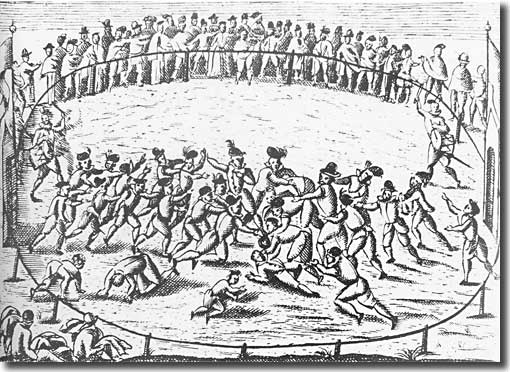 earliest forms were far removed from today's version of the game. There
are records of examples in China, as long ago as 200 BC, as well as others
in Ancient Greece and the Roman Empire.
earliest forms were far removed from today's version of the game. There
are records of examples in China, as long ago as 200 BC, as well as others
in Ancient Greece and the Roman Empire.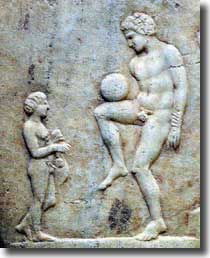 Games
were normally violent and disorganised affairs with any number of players
- it was not uncommon for 1,000 people to play in a single game. By the
11th Century, games were often played between rival villages and the "pitch"
could be an incredibly large area. The "pitch" was not a defined
size with a parameter, but included streets, fields, village squares and
anything else that got in the way!
Games
were normally violent and disorganised affairs with any number of players
- it was not uncommon for 1,000 people to play in a single game. By the
11th Century, games were often played between rival villages and the "pitch"
could be an incredibly large area. The "pitch" was not a defined
size with a parameter, but included streets, fields, village squares and
anything else that got in the way!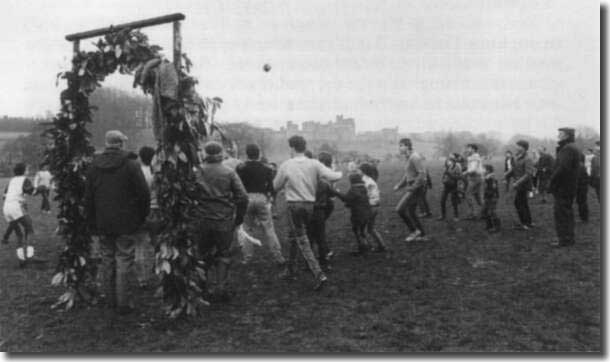 At
Kingston, indeed, there grew up the tradition that the right of playing
was gained for the inhabitants by the bravery of their forebears who defeated
the Danes in a marauding battle, and having cut off the head of the Danish
general, kicked it about in triumph.
At
Kingston, indeed, there grew up the tradition that the right of playing
was gained for the inhabitants by the bravery of their forebears who defeated
the Danes in a marauding battle, and having cut off the head of the Danish
general, kicked it about in triumph.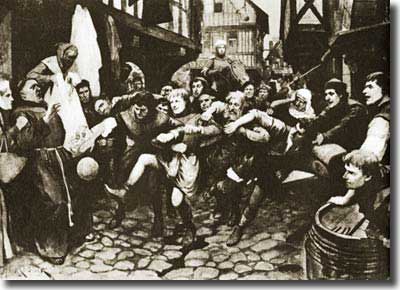 reasons
when he saw the simple joy of the players romping after the ball. This
supporter was Richard Mulcaster, the great pedagogue, head of the famous
schools of Merchant Taylor's and St. Paul's. He pointed out that the game
had positive educational value and it promoted health and strength. He
claimed that all that was needed was to refine it a little and give it
better manners. His notion was that the game would benefit most if the
number of participants in each team were limited and, more importantly,
there were a stricter referee.'
reasons
when he saw the simple joy of the players romping after the ball. This
supporter was Richard Mulcaster, the great pedagogue, head of the famous
schools of Merchant Taylor's and St. Paul's. He pointed out that the game
had positive educational value and it promoted health and strength. He
claimed that all that was needed was to refine it a little and give it
better manners. His notion was that the game would benefit most if the
number of participants in each team were limited and, more importantly,
there were a stricter referee.'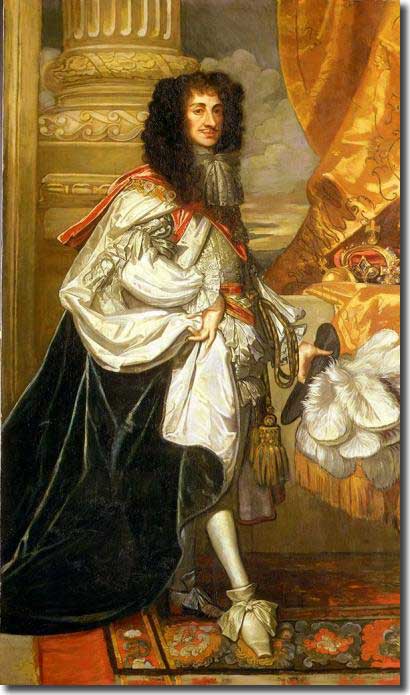 for
a spell. The political hold of this creed was short. But the effect it
had upon the nation put a large stop not only to Sunday football, but
to the playing of the game on other days also.
for
a spell. The political hold of this creed was short. But the effect it
had upon the nation put a large stop not only to Sunday football, but
to the playing of the game on other days also.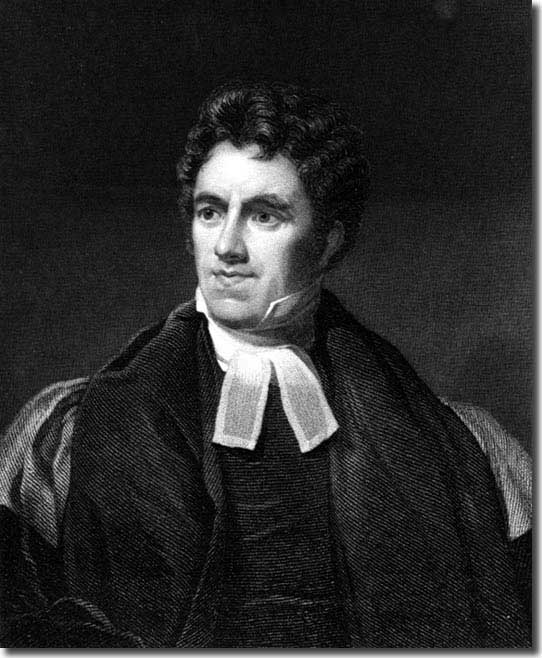 was
merely in a state of dormancy. It soon picked up again and it did so during
the 1850s at a time when the period of 'muscular Christianity' came into
vogue under the lead given by the great public schools of the land. Thus
it is true to say that while the "manly game of football" has
flourished for centuries in these islands, it was the public schools who
took it from the streets and the fields, civilised it, brought law and
order and system to it (though most of the schools had their own rules
differing from each other), until finally it was shaped and polished and
unified under one set of rules drawn up for national acceptance by the
Football Association in 1863. Nor can we forget the Universities of Cambridge,
and later Oxford, who were to take their place in this developing process
of creating one set of laws so that all could play and enjoy the same
game.'
was
merely in a state of dormancy. It soon picked up again and it did so during
the 1850s at a time when the period of 'muscular Christianity' came into
vogue under the lead given by the great public schools of the land. Thus
it is true to say that while the "manly game of football" has
flourished for centuries in these islands, it was the public schools who
took it from the streets and the fields, civilised it, brought law and
order and system to it (though most of the schools had their own rules
differing from each other), until finally it was shaped and polished and
unified under one set of rules drawn up for national acceptance by the
Football Association in 1863. Nor can we forget the Universities of Cambridge,
and later Oxford, who were to take their place in this developing process
of creating one set of laws so that all could play and enjoy the same
game.'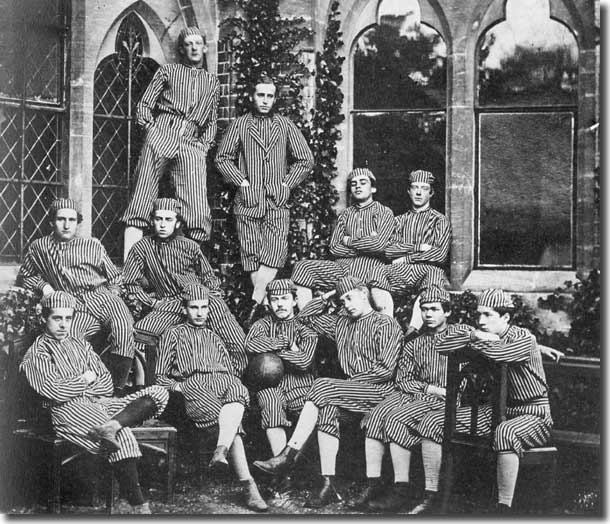 school
rules, or knew them by heart, and our progress in framing new rules was
slow.'
school
rules, or knew them by heart, and our progress in framing new rules was
slow.'